Creation of Backfill Materials Based on Industrial Waste
Abstract
:1. Introduction
2. Industrial Waste in the Laying Composite—A Method for Their Disposal
3. Preparation of the Backfill Composite Based on Industrial Waste
- increases the strength of the fill mass;
- adjusts the rheological properties of the backfill composite, which improves its transportability.
4. Discussion on Non-Waste (Low-Waste) Production as the Paradigm of Sustainable Development of Mining Regions
- increase in the mineral resource base of mining and processing enterprises;
- reduction of production costs;
- increase in quality indicators during production and processing;
- reduction of losses of minerals during extraction and useful component during processing;
- reducing the cost of mining operations by replacing specially extracted components of the fill composite with man-made waste;
- reducing the cost of storing man-made waste by involving it in a closed cycle of main and auxiliary production.
- improving the health and life quality of the mining regions’ population by significantly reducing the impact on the ecosystem, and as a result, significantly improving the environmental situation by reducing the amount of man-made waste stored on the surface;
- increasing the effective operation life of the mining enterprise due to the development of the blocks, involvement in the industrial use of substandard and poor ores, including the processing of man-made waste in the production cycle;
- more complete use of the mineral resource base of the region, due to the implementation of the useful components’ extraction from low-value and off-balance ores, as well as man-made waste and complex processing of mineral raw materials;
- reduction of costs for the operation and construction of man-made storage facilities, as well as for environmental deductions;
- creation of innovative production facilities for new types of products that are not typical for a mining enterprise;
- increasing the competitive position and improving financial stability in the context of globalization through the introduction of high-performance physical, chemical and physical-technical technologies at mining enterprises with natural and man-made raw materials.
5. Conclusions
6. Final Remarks and Prospects for Further Studies
Author Contributions
Funding
Data Availability Statement
Conflicts of Interest
References
- Samarina, V.P. Mineral resource industry of Russia in the world market: Current developments. Min. Inf. Anal. Bull. 2017, 3, 209–216. [Google Scholar]
- Resniovam, E.; Ponomarenko, T. Sustainable Development of the Energy Sector in a Country Deficient in Mineral Resources: The Case of the Republic of Moldova. Sustainability 2021, 13, 3261. [Google Scholar] [CrossRef]
- Ponomarenko, T.; Nevskaya, M.; Jonek-Kowalska, I. Mineral Resource Depletion Assessment: Alternatives. Problems. Results. Sustainability 2021, 13, 862. [Google Scholar] [CrossRef]
- Grayson, R.L. Addressing the Dual Challenges of Meeting Demand for Minerals and Sustainable Development. Minerals 2011, 1, 1. [Google Scholar] [CrossRef] [Green Version]
- Tost, M.; Ammerer, G.; Kot-Niewiadomska, A.; Gugerell, K. Mining and Europe’s World Heritage Cultural Landscapes. Resources 2021, 10, 18. [Google Scholar] [CrossRef]
- Khayrutdinov, A.M.; Kongar-Syuryun, C.B.; Kowalik, T.; Tyulyaeva, Y.S. Stress-strain behavior control in rock mass using different-stregth backfill. Min. Inf. Anal. Bull. 2020, 10, 42–55. [Google Scholar] [CrossRef]
- Rybak, J.M.; Kongar-Syuryun, C.; Tyulyaeva, Y.; Khayrutdinov. A, M.; Akinshin, I. Geomechanical substantiation of parameters of technology for mining salt deposits with a backfill. Min. Sci. 2021, 28, 19–32. [Google Scholar] [CrossRef]
- Golik, V.I.; Burdzieva, O.G. Increase of work safety by enlargement of field of application of hardening mixtures from processing waste. Occup. Saf. Ind. 2016, 8, 45–50. [Google Scholar]
- Zeqiri, K. Investigation of the mining accidents at “Stan Terg” mine. Min. Sci. 2020, 27, 39–46. [Google Scholar] [CrossRef]
- Sukhorukova, M.; Ivannikov, A. Vehicle accident risk assessment in mines. Min. Inf. Anal. Bull. 2020, 6, 224–232. [Google Scholar] [CrossRef]
- Gendler, S.; Prokhorova, E. Risk-Based Methodology for Determining Priority Directions for Improving Occupational Safety in the Mining Industry of the Arctic Zone. Resources 2021, 10, 20. [Google Scholar] [CrossRef]
- Amrani, M.; Rachid, C.; Azzedine, B.; Verzea, I. Well-being at work: A lever for sustainable performance in workplace. Min. Sci. 2020, 27, 89–104. [Google Scholar] [CrossRef]
- Yu, L.; Ignatov, Y.; Ivannikov, A.; Khotchenkov, E.; Krasnoshtanov, D. Common features in the manifestation of natural and induced geodynamic events in the eastern regions of Russia and China. IOP Conf. Ser. Earth Environ. Sci. 2019, 324, 012004. [Google Scholar] [CrossRef]
- Golik, V.I.; Gabaraev, O.Z.; Maslennikov, S.A.; Khasheva, Z.M.; Shulgaty, L.P. The provision of development conversion perspectives into undeground one for Russian iron ore deposits development. Soc. Sci. 2016, 11, 4348–4351. [Google Scholar]
- Parkasiewicz, B.; Kadela, M.; Bȩtkowski, P.; Sieńko, R.; Bednarski, Ł. Application of Structure Monitoring Systems to the Assessment of the Behaviour of Bridges in Mining Areas. IOP Conf. Ser. Mat. Sci. Eng. 2017, 245, 032018. [Google Scholar] [CrossRef]
- Öhlander, B.; Chatwin, T.; Alakangas, L. Management of Sulfide-Bearing Waste, a Challenge for the Mining Industry. Minerals 2012, 2, 1–10. [Google Scholar] [CrossRef]
- Menshikova, E.; Fetisov, V.; Karavaeva, T.; Blinov, S.; Belkin, P.; Vaganov, S. Reducing the Negative Technogenic Impact of the Mining Enterprise on the Environment through Management of the Water Balance. Minerals 2020, 10, 1145. [Google Scholar] [CrossRef]
- Eron’ko, S.P.; Danilov, V.L.; Kuklev, A.V.; Tkachev, M.Y.; Tinyakov, V.V.; Mechik, S.V. Experience of Design and Industrial Application of Systems for the Driven Feed of Slag-Forming Mixtures into the Crystallizers of Slab CCM. Metallurgist 2020, 64, 214–222. [Google Scholar] [CrossRef]
- Golik, V.; Komaschenko, V.; Morkun, V.; Khasheva, Z. The effectiveness of combining the stages of ore fields development. Metall. Min. Ind. 2015, 7, 401–405. [Google Scholar]
- Golik, V.I.; Razorenov, Y.I.; Lukyanov, V.G. Environmental and economic aspects of resource saving in mining. Bull. Tomsk Polytech. Univ. Geo Assets Eng. 2017, 328, 18–27. [Google Scholar]
- Kowalik, T.; Ubysz, A. Waste basalt fibers as an alternative component of fiberconcrete. Mater. Today Proc. 2021, 38, 2055–2058. [Google Scholar] [CrossRef]
- Pizoń, J.; Gołaszewski, J.; Alwaeli, M.; Szwan, P. Properties of Concrete with Recycled Concrete Aggregate Containing Metallurgical Sludge Waste. Materials 2020, 13, 1448. [Google Scholar] [CrossRef] [Green Version]
- Kawalec, J.; Kwiecień, S.; Pilipenko, A.; Rybak, J. Application of crushed concrete in geotechnical engineering-selected issues. IOP Conf. Ser. Earth Environ. Sci. 2017, 95, 022057. [Google Scholar] [CrossRef]
- Long, H.; Liu, H.; Li, X.; Chen, L. An Evolutionary Game Theory Study for Construction and Demolition Waste Recycling Considering Green Development Performance under the Chinese Government’s Reward–Penalty Mechanism. Int. J. Environ. Res. Public Health 2020, 17, 6303. [Google Scholar] [CrossRef] [PubMed]
- Khayrutdinov, M.M.; Kongar-Syuryun, C.B.; Tyulyaeva, Y.S.; Khayrutdinov, A.M. Cementless backfill mixtures based on water-soluble manmade waste. Bull. Tomsk Polytech. Univ. Geo Assets Eng. 2020, 331, 30–36. [Google Scholar] [CrossRef]
- Noui, A.; Bouglada, M.S.; Belagraa, L.; Achour, Y.; Abderazak, B. Study of the mechanical behavior and durability of mortars based on prepared sand. Min. Sci. 2020, 27, 47–59. [Google Scholar] [CrossRef]
- Golik, V.; Dmytrak, Y.; Sergeev, V.; Vernigor, V. Impact of Tailing Dumps on the Environment of the Mining Region. Ecol. Ind. Russ. 2018, 22, 44–48. [Google Scholar] [CrossRef]
- Bac-Bronowicz, J.; Kowalczyk, P.; Bartlewska-Urban, M. Risk Reduction of a Terrorist Attack on a Critical Infrastructure Facility of LGOM Based on the Example of the Żelazny Most Tailings Storage Facility (OUOW Żelazny Most). Studia Geotech. Mech. 2020, 42, 376–387. [Google Scholar] [CrossRef]
- Sidorova, E. Modern strategic decisions in the field of waste as a basis of development of circular economy and greening of industrial production. In Proceedings of the 19th International Multidisciplinary Scientific Geo Conference (SGEM 2019), Albena, Bulgaria, 28 June–6 July 2019; pp. 531–538. [Google Scholar]
- Radyuk, A.G.; Gorbatyuk, S.M.; Tarasov, Y.S.; Titlyanov, A.E.; Aleksakhin, A.V. Improvements to Mixing of Natural Gas and Hot-Air Blast in the Air Tuyeres of Blast Furnaces with Thermal Insulation of the Blast Duct. Metallurgist 2019, 63, 433–440. [Google Scholar] [CrossRef]
- Ermolovich, O.V.; Ermolovich, E.A. Composite backfilling materials with the addition of of mechanically activated beneficiation tailings. Bull. Tula State Univ. Earth Sci. 2016, 3, 24–30. [Google Scholar]
- Melnik, V.V.; Vasyuchkov, Y.F. Principles of Increasing Safety at the Development of Coal Deposits. Occup. Saf. Ind. 2016, 8, 51–53. [Google Scholar]
- Sarychev, V.I.; Melnik, V.V.; Golodov, M.A.; Zubakov, I.N.; Zhukov, S.S. Technological schemes of mining by cells with widening and backfilling open areas. Bull. Tula State Univ. Earth Sci. 2011, 2, 203–206. [Google Scholar]
- Melnik, V.V.; Kozlov, V.V. Analysis of research and state of the hydraulic technology and process of coal mining. Russ. Coal J. 2017, 2, 16–17. [Google Scholar] [CrossRef]
- Golik, V.I. Metal leaching technologies-the way of reanimation of mining Ossetia. Sustain. Dev. Mt. Territ. 2020, 12, 273–282. [Google Scholar] [CrossRef]
- Szyszka, D. Frother critical coalescence concentration and dose in flotation of copper-bearing carbonaceous shale. Min. Sci. 2019, 26, 289–295. [Google Scholar] [CrossRef]
- Szyszka, D. Critical coalescence concentration (Ccc) for surfactants in aqueous solutions. Minerals 2018, 8, 431. [Google Scholar] [CrossRef] [Green Version]
- Zglinicki, K.; Szamałek, K.; Wołkowicz, S. Critical Minerals from Post-Processing Tailing. A Case Study from Bangka Island, Indonesia. Minerals 2021, 11, 352. [Google Scholar] [CrossRef]
- Kaplunov, D.R. Comprehensive exploitation of mineral resources is a major trend in design of ore mines. Min. Inf. Anal. Bull. 2014, S1, 347–357. [Google Scholar]
- Golik, V.I.; Razorenov, Y.I.; Maslennikov, S.A. Protection of natural geological environment by utilizing ore tailings. Bull. Tomsk Polytech. Univ. Geo Assets Eng. 2015, 326, 6–15. [Google Scholar]
- Hefni, M.; Ahmed, H.A.M.; Omar, E.S.; Ali, M.A. The Potential Re-Use of Saudi Mine Tailings in Mine Backfill: A Path towards Sustainable Mining in Saudi Arabia. Sustainability 2021, 13, 6204. [Google Scholar] [CrossRef]
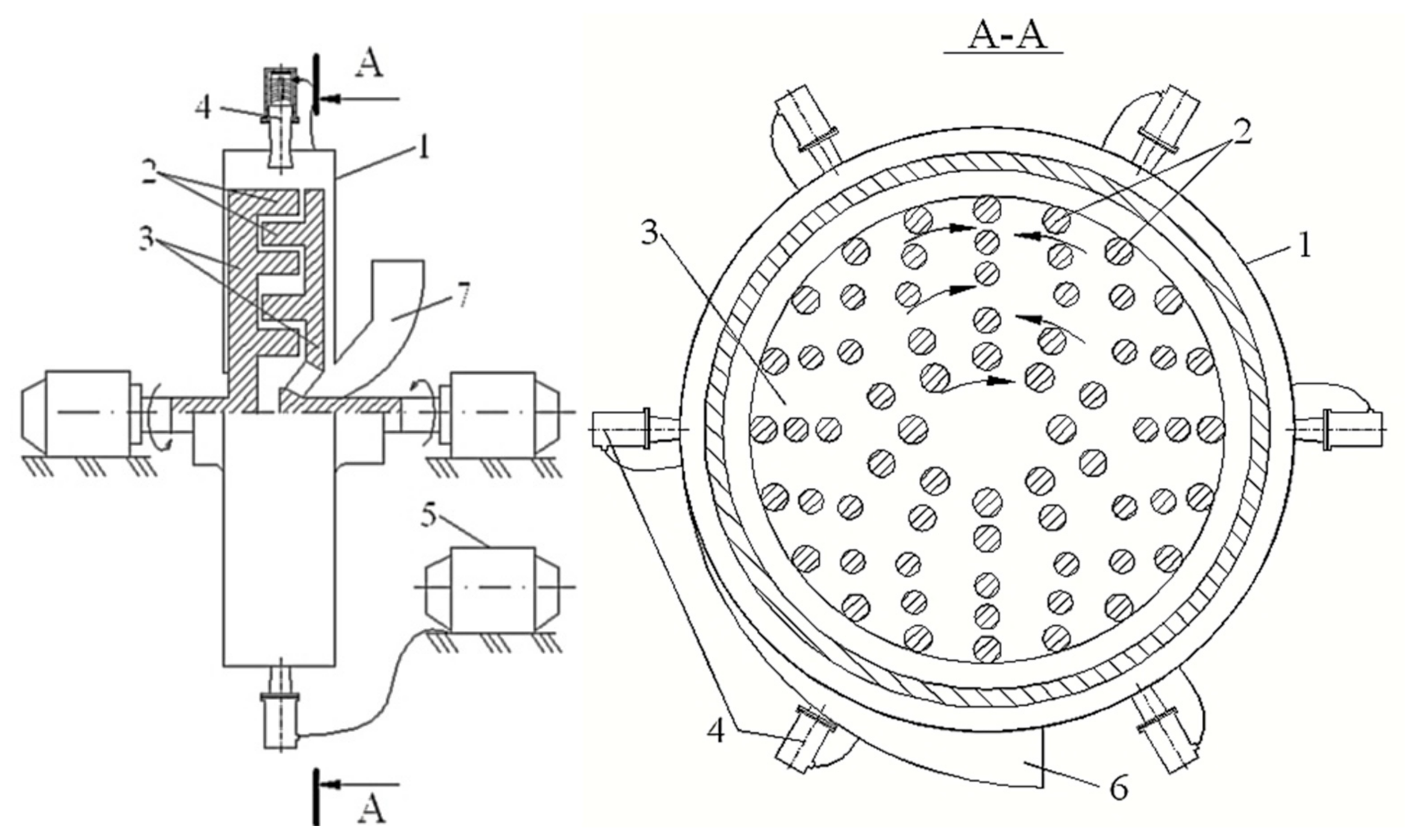
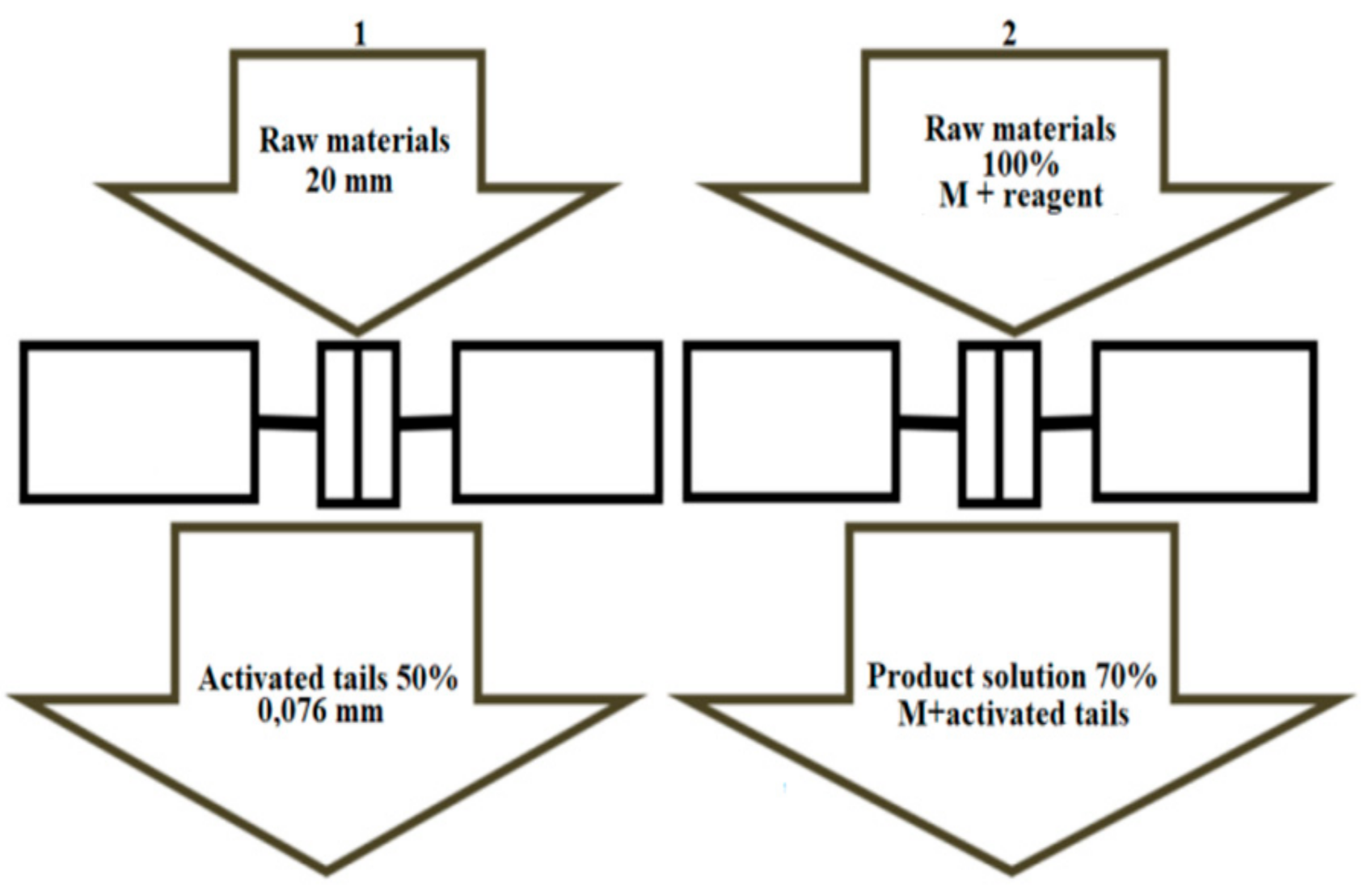
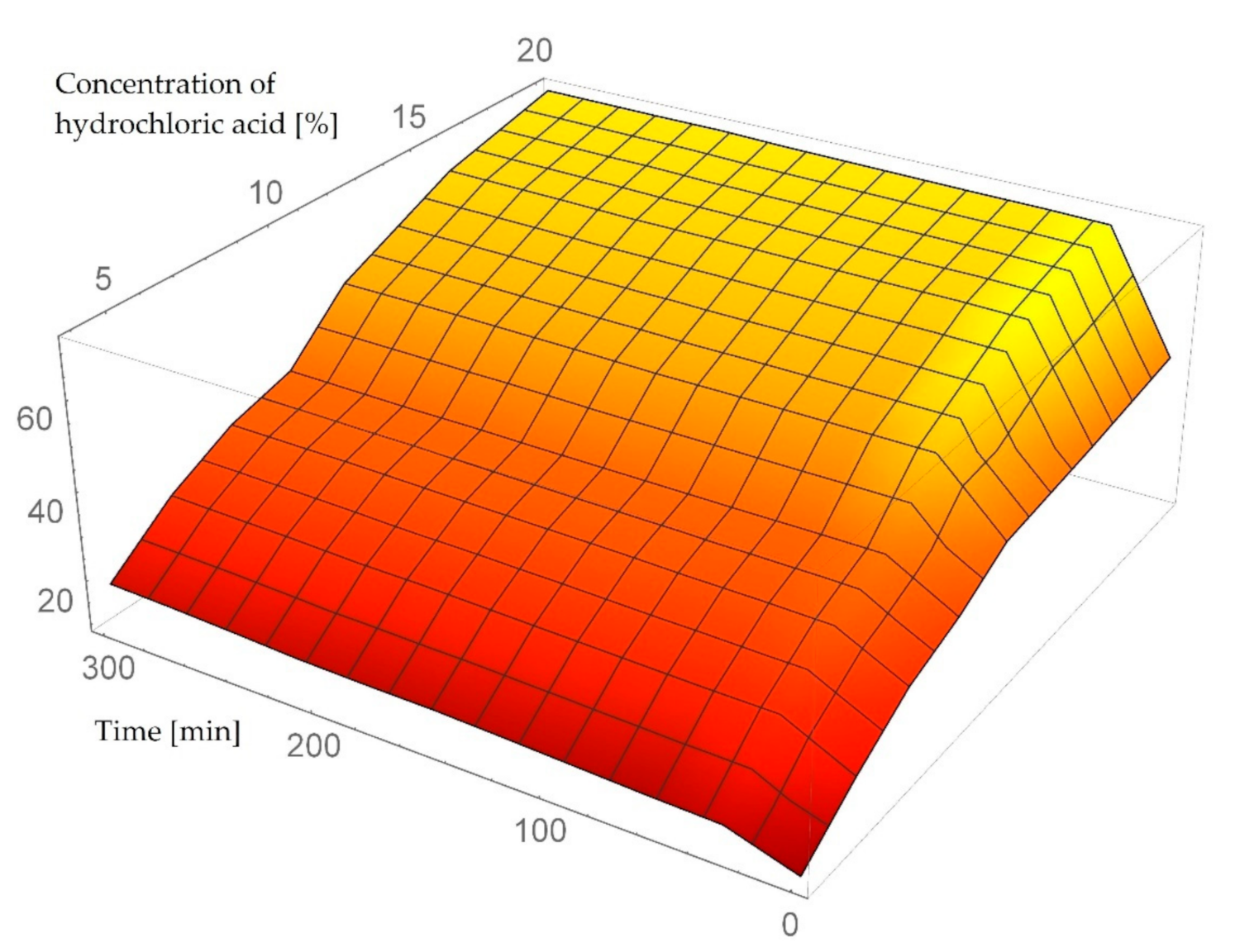
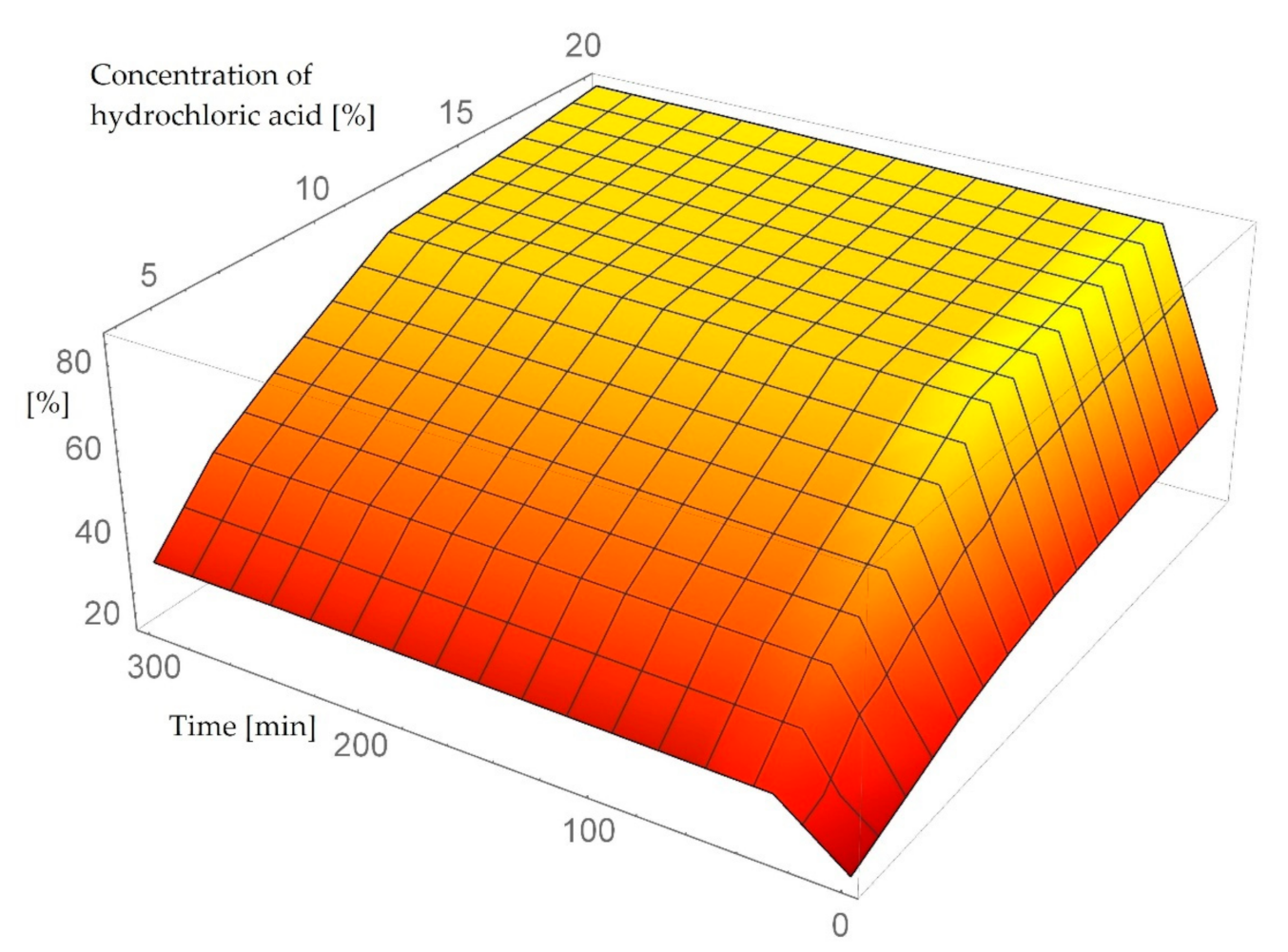
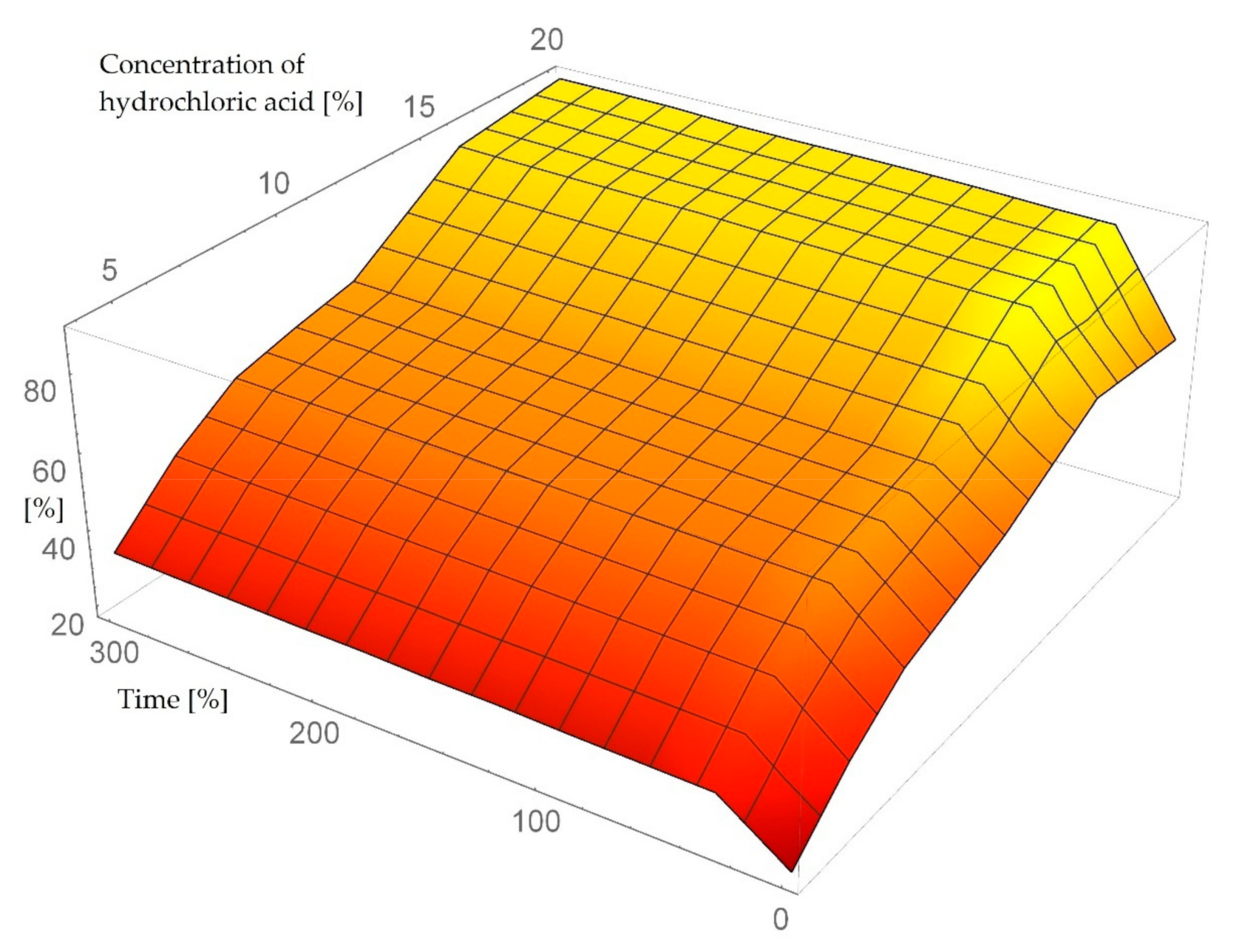
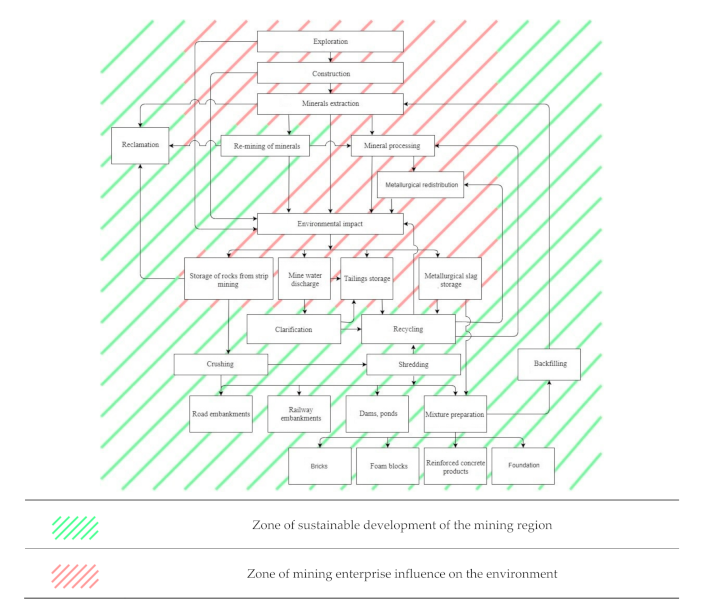
| Activation Treatment, min. | Concentration of Hydrochloric Acid in Solution, % | ||||||
|---|---|---|---|---|---|---|---|
| 4.0 | 6.0 | 8.0 | 10.0 | 12.0 | 16.0 | 20.0 | |
| 0 | 9.8 | 19.1 | 27.1 | 31.6 | 38.1 | 40.8 | 44.2 |
| 30 | 14.7 | 26.7 | 34.9 | 40.2 | 52.7 | 64.9 | 70.9 |
| 60 | 15.1 | 26.9 | 35.3 | 40.3 | 52.8 | 65.2 | 71.2 |
| 90 | 15.7 | 27.3 | 35.5 | 40.3 | 52.9 | 65.2 | 71.3 |
| 120 | 16.3 | 27.7 | 35.9 | 40.4 | 53.0 | 65.3 | 71.5 |
| 150 | 16.8 | 28.1 | 36.1 | 40.5 | 53.0 | 65.4 | 71.7 |
| 180 | 16.9 | 28.5 | 36.3 | 40.6 | 53.3 | 65.4 | 71.9 |
| 210 | 17.2 | 28.6 | 36.6 | 40.8 | 53.5 | 65.4 | 72.3 |
| 240 | 17.9 | 29.1 | 36.9 | 40.8 | 53.7 | 65.7 | 72.3 |
| 270 | 18.5 | 29.4 | 37.0 | 41.0 | 53.8 | 65.9 | 72.4 |
| 300 | 18.9 | 29.7 | 37.1 | 41.2 | 53.8 | 66.1 | 72.5 |
| Activation Treatment, min. | Concentration of Hydrochloric Acid in Solution, % | ||||||
|---|---|---|---|---|---|---|---|
| 4.0 | 6.0 | 8.0 | 10.0 | 12.0 | 16.0 | 20.0 | |
| 0 | 12.3 | 17.6 | 23.1 | 26.9 | 29.8 | 33.0 | 35.9 |
| 30 | 24.9 | 42.1 | 52.4 | 61.5 | 70.6 | 74.7 | 78.9 |
| 60 | 25.2 | 42.4 | 52.7 | 61.8 | 70.9 | 75.0 | 79.2 |
| 90 | 25.5 | 42.7 | 53.0 | 62.1 | 71.2 | 75.3 | 79.5 |
| 120 | 25.8 | 43.0 | 53.3 | 62.4 | 71.5 | 75.6 | 79.8 |
| 150 | 26.1 | 43.3 | 53.6 | 62.7 | 71.8 | 75.9 | 80.1 |
| 180 | 26.4 | 43.6 | 53.9 | 63.0 | 72.1 | 76.2 | 80.4 |
| 210 | 26.7 | 43.9 | 54.2 | 63.3 | 72.4 | 76.5 | 80.7 |
| 240 | 27.0 | 44.2 | 54.5 | 63.6 | 72.7 | 76.8 | 81.0 |
| 270 | 27.1 | 44.3 | 54.6 | 63.7 | 72.8 | 76.9 | 81.1 |
| 300 | 27.3 | 44.5 | 54.8 | 63.9 | 73.0 | 77.1 | 81.3 |
| Activation Treatment, min. | Concentration of Hydrochloric Acid in Solution, % | ||||||
|---|---|---|---|---|---|---|---|
| 4.0 | 6.0 | 8.0 | 10.0 | 12.0 | 16.0 | 20.0 | |
| 0 | 18.6 | 32.1 | 42.2 | 46.9 | 51.8 | 65.6 | 61.5 |
| 30 | 30.9 | 46.2 | 56.7 | 60.5 | 63.8 | 83.8 | 87.4 |
| 60 | 31.2 | 46.5 | 57.0 | 60.8 | 64.1 | 84.1 | 87.7 |
| 90 | 31.5 | 46.8 | 57.3 | 61.1 | 64.4 | 84.4 | 88.3 |
| 120 | 32.0 | 47.1 | 57.6 | 61.4 | 64.7 | 84.7 | 88.7 |
| 150 | 32.1 | 47.5 | 57.9 | 61.7 | 65.0 | 85.0 | 88.9 |
| 180 | 32.6 | 47.7 | 58.2 | 62.0 | 65.3 | 85.6 | 89.0 |
| 210 | 32.7 | 48.0 | 58.5 | 62.2 | 65.4 | 85.7 | 89.3 |
| 240 | 33.0 | 48.3 | 58.8 | 62.3 | 65.8 | 85.9 | 90.0 |
| 270 | 33.3 | 48.3 | 58.9 | 62.9 | 66.1 | 86.2 | 90.3 |
| 300 | 33.7 | 48.6 | 59.1 | 63.1 | 66.4 | 86.6 | 90.4 |
| No | Fill Material Components | Spreading (mm) | Cone Draft (sm) | Ultimate Strength in Uniaxial Compression (MPa) | ||||||||
|---|---|---|---|---|---|---|---|---|---|---|---|---|
| Chusovsky | Gaysky | Cement (%) | Water (wt.%) | |||||||||
| Inactivated | Activated | Inactivated | Activated | Cementing Duration (Days) | ||||||||
| 7 | 28 | 60 | 90 | |||||||||
| 1 | 0 | 0 | 70 | 0 | 5 | 25 | 110 | 12 | 0.19 | 2.00 | 2.75 | 3.10 |
| 2 | 0 | 0 | 0 | 70 | 5 | 25 | 120 | 14 | 0.26 | 2.70 | 3.72 | 4.20 |
| 3 | 0 | 0 | 0 | 73 | 2 | 25 | 110 | 13 | 0.21 | 2.20 | 2.95 | 3.35 |
| 4 | 15 | 0 | 58 | 0 | 2 | 25 | 95 | 10 | 0.15 | 1.70 | 2.25 | 2.75 |
| 5 | 15 | 0 | 0 | 58 | 2 | 25 | 100 | 10 | 0.19 | 2.10 | 2.75 | 3.10 |
| 6 | 0 | 15 | 58 | 0 | 2 | 25 | 100 | 11 | 0.21 | 2.20 | 2.85 | 3.15 |
| 7 | 0 | 15 | 0 | 58 | 2 | 25 | 115 | 12 | 0.26 | 2.65 | 3.8 | 4.10 |
| 8 | 25 | 0 | 50 | 0 | 0 | 25 | 105 | 10 | 0.10 | 1.45 | 2.00 | 2.35 |
| 9 | 25 | 0 | 0 | 50 | 0 | 25 | 105 | 11 | 0.14 | 1.95 | 2.70 | 3.15 |
| 10 | 0 | 25 | 50 | 0 | 0 | 25 | 110 | 13 | 1.45 | 1.72 | 2.60 | 2.95 |
| 11 | 0 | 25 | 0 | 50 | 0 | 25 | 145 | 15 | 0.24 | 2.75 | 3.80 | 4.15 |
Publisher’s Note: MDPI stays neutral with regard to jurisdictional claims in published maps and institutional affiliations. |
© 2021 by the authors. Licensee MDPI, Basel, Switzerland. This article is an open access article distributed under the terms and conditions of the Creative Commons Attribution (CC BY) license (https://creativecommons.org/licenses/by/4.0/).
Share and Cite
Rybak, J.; Kongar-Syuryun, C.; Tyulyaeva, Y.; Khayrutdinov, A.M. Creation of Backfill Materials Based on Industrial Waste. Minerals 2021, 11, 739. https://doi.org/10.3390/min11070739
Rybak J, Kongar-Syuryun C, Tyulyaeva Y, Khayrutdinov AM. Creation of Backfill Materials Based on Industrial Waste. Minerals. 2021; 11(7):739. https://doi.org/10.3390/min11070739
Chicago/Turabian StyleRybak, Jarosław, Cheynesh Kongar-Syuryun, Yulia Tyulyaeva, and Albert M. Khayrutdinov. 2021. "Creation of Backfill Materials Based on Industrial Waste" Minerals 11, no. 7: 739. https://doi.org/10.3390/min11070739
APA StyleRybak, J., Kongar-Syuryun, C., Tyulyaeva, Y., & Khayrutdinov, A. M. (2021). Creation of Backfill Materials Based on Industrial Waste. Minerals, 11(7), 739. https://doi.org/10.3390/min11070739







